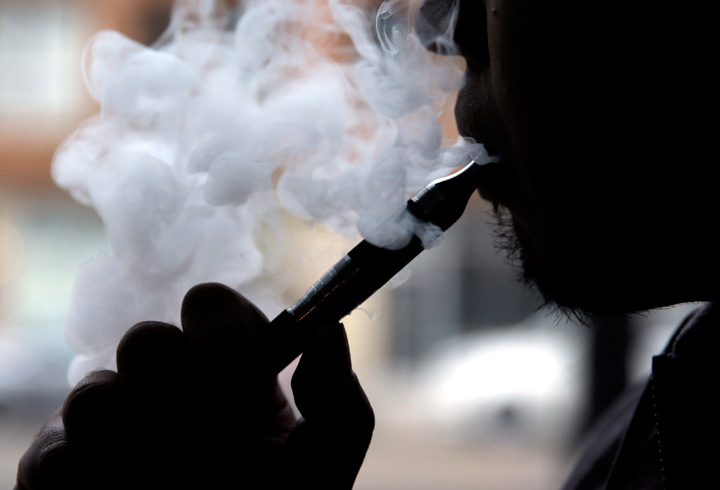Vape ’em if you’ve got em: Ontario students are ditching regular cigarettes for their e-cigarette cousins, a CAMH survey has found.

The Centre for Addiction and Mental Health released its 2015 survey on Ontario students’ drug and alcohol use on Wednesday. The survey, which is done every two years, asks students from grades 7-12 about their drug use over the past year.
Here are some of the most interesting findings:
1. E-cigarettes have overtaken regular tobacco use
12 per cent of students reported using e-cigarettes in the past year, compared to eight per cent who smoked a regular cigarette. This includes e-cigarettes with and without nicotine – in many cases, the students themselves didn’t know what kind they had smoked.
“I think a lot of public health efforts have been put into reducing smoking of tobacco cigarettes,” said Dr. Hayley Hamilton, a research scientist at CAMH and co-lead on the survey project. These public health campaigns seem to have succeeded – to a point anyway.
But the trend could indicate some persistent misconceptions when it comes to the health risks of cigarette alternatives.
“I think there is an assumption or a belief that e-cigarettes are less harmful than tobacco cigarettes,” she said. “The problem is that the data, the research to date is inconclusive with respect to the impacts or effects of e-cigarettes.”
2. More students have taken prescription opioids recreationally than smoked a cigarette
How uncool have cigarettes become? More Ontario students report non-medical use of prescription opioids than smoked cigarettes in the last year. 10 per cent of students report using an opioid pain reliever non-medically, compared to eight per cent who smoked cigarettes. 59 per cent of opioid users said they obtained the drug from someone at home.
This comes as prescription opioids take a growing toll on Canadians. In 2011, Ontarians were more likely to die from prescription opioid overdoses than as the driver in a car accident.
“You’re using drugs without a prescription, without your own prescription. So you’re using them without medical supervision. And they’re highly addictive,” Hamilton said.
3. Almost half of students report drinking alcohol
46 per cent of students report drinking alcohol in the past year. That number increases grade by grade. By Grade 12, 72 per cent of students report having a drink. The average age respondents were when they had their first drink was 14.78 years old, which would put them likely in Grade 9 or 10.
“At 15 and younger, they’re still developing. Their bodies and their brains are still developing,” Hamilton said. Drinking while that young can impact physical development, she said, and could lead to chronic disease.
46 per cent of students report that a family member gave them alcohol in the past year. 20.5 per cent said they got it from a friend, 14 per cent say they paid someone to buy it for them and 7 per cent raided their parents’ liquor cabinet.
4. One in five high school students reported getting blackout drunk
19 per cent of high school students reported that at least once in the past year, they got so drunk they couldn’t remember what had happened. 18 per cent of students in grades 7-12 reported binge-drinking in the past month – defined as consuming five or more drinks on one occasion. 33 per cent of Grade 12 students reported binge-drinking in the month before the survey.
That’s a concern, Hamilton said.
“Drinking that much in a single occasion, that should not happen at this age, or at any age,” she said.
One thing worrying doctors is unintentional injuries as a result of drinking. Heavy drinking makes people take risks that they shouldn’t, Hamilton said. It can result in drunk driving or injury. Nine per cent of survey respondents said they were injured or injured somebody else while drinking.
5. Ontario students are cleaner than ever
Despite everything mentioned above, drug use among Ontario junior high and high school students continues to fall, according to the survey.
Cigarette, alcohol and marijuana use has plummeted among Ontario’s junior high and high school students since the 1970s and even more recently. In 1999, 66 per cent of students reported drinking in the previous year. Now it’s 45 per cent. Similar decreases were seen in nearly every drug measured in the survey.
The one major exception: non-prescription use of ADHD medication, which rose from 1 per cent of respondents in 2007 to 2.1 per cent in 2015.
“In a sense we are encouraged by the declines, but we do recognize that the numbers and the prevalence are still very high for certain drugs and therefore we are concerned because of the possibility of harm, especially those that are lacking in regulation,” Hamilton said – like energy drinks and e-cigarettes.
42 per cent of students in grades 7 to 12 report using no drugs whatsoever – with the exception of energy drinks. This is much higher than it was in 1999, when only 27 per cent of students said they hadn’t used any drugs, tobacco or alcohol in the last year. But as students get older, the more likely they are to have consumed some controlled substance: only 22 per cent of Grade 12 students surveyed said they had not.
The full CAMH Ontario Student Drug Use and Health Survey is available on their website.




Comments